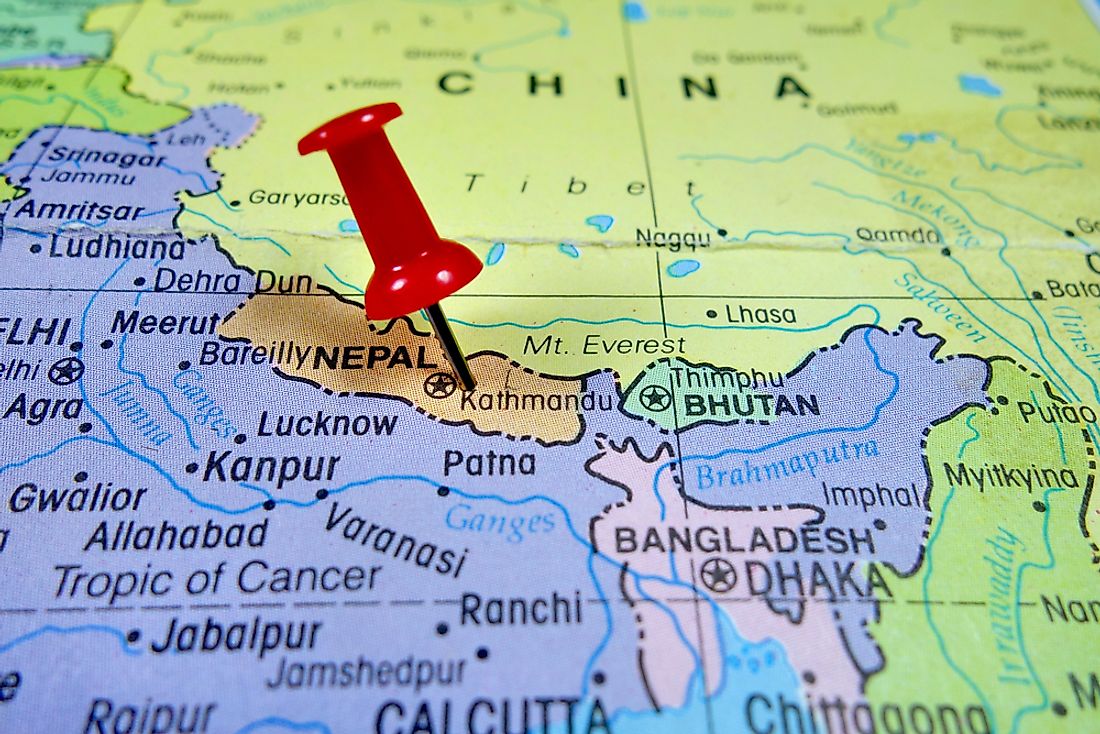Where is Nepal Located?

The Location of Nepal
The Federal Democratic Republic of Nepal is a landlocked country located in Southern Asia. It is the largest sovereign Himalayan state with a population of about 26.4 million people. Nepal covers a total of 147,181 square kilometers. Out of this, 143,351 square kilometers is land and 3,830 square kilometers is the water area of the country. This coverage makes Nepal the 94th largest nation in the world.
Nepal borders China to the north and India to the east, south, and west. In China, the Tibet Autonomous Region bounds Nepal from China while the Indian states of Sikkim, Bihar and Uttar Pradesh demarcate the Indian boundaries from Nepal. The country of Nepal lies between latitudes 26 and 31 degrees north, and longitudes 80 and 89 degrees east.
A Brief History of Nepal
Nepal experienced a struggle for democracy in the 20th century and early 21st century. The country was governed by the Shah dynasty for over 200 years. In June 2006, a Peace Treaty was signed ending the monarchial reign of the Shah. Elections were held the same year and Nepal became a Republic. Ram Baran Yadav became the first president on July 23, 2008.
Government Structures
Nepal has 7 states, 75 districts, and 744 local units. The President is the head of state whereas the Prime Minister holds the position of head of the executive. The President’s roles are largely ceremonial since the Prime Minister entirely manages the functioning of government.
Major Cities
The capital city of Nepal is Kathmandu. Kathmandu is also the largest city in Nepal. Other cities of Nepal include Pokhara, Lalitpur, Bharatpur, Nepalgunj, Bhim Datta, Hetauda, Janakpuri, and Butwal.
Demographics
Nepal is a Developing Country ranking 144th on the Human Development Index (HDI) as of 2016. It is also one of the poorest countries in the world. It ranks 197th in GDP. Many Nepalese live below the poverty line.
The citizens of Nepal are known as Nepali or Nepalese. The widely spoken language in Nepal is Nepali with 44.6% being able to speak it. Nepali is also the country’s official language. The Maithili language follows with 11.7%. Other languages spoken are Bhojpuri, Tharu, Nepal Bhasa, Bajjika, Magar, Doteli, Urdu, Tamag, and Sunwar.
Nepalese are predominantly of Hindu religion. Hinduism is practiced by 81.3% of the total population of Nepal. Lord Shiva Temple, where Hindus all over the world go for pilgrimage, is found in Nepal. Buddhism, Islam, Christianity, and Animism constitute less than 10%.
Nepal’s national cuisine is Dhindo and Gundruk. Dal Bhat is the staple food. It is a lentil soup (Dat) served over boiled rice (Bhat) together with vegetables and spices.
Flag of Nepal
The flag of Nepal is the only one in the world that does not have a rectangular shape. The flag has three colors; red, blue, and white. The red color represents aggression, the blue border represents peace, the curved white moon represents peace and calmness of the Nepali people. The white sun represents aggressiveness of the Nepali warriors.
Natural Wealth
The country boasts a great natural scenery which includes mountains, plains, hills, and forests. Approximately 75% of the country is covered by mountains. Eight of the world’s 10 highest mountains on Earth are found in Nepal. Nepal is home to Mt. Everest and Mt. Kanchenjunga, the highest and 3rd highest mountains on earth.
Nepal experiences natural hazards such as floods, landslides, drought, and earthquakes. In 1934, the country suffered a catastrophic earthquake of an 8.1 magnitude. Most recently on April 25, 2015, Nepal was hit by another 7.8 magnitude earthquake.







